Creating a more drought tolerant garden the right way.
Evelyn Wolf, 2001

Sneaking out at midnight with a watering can during a water ban is not the time or way to protect your plants when a dry spell hits! Spring and early summer is when to prepare your plants for the inevitable heat and drought of high summer by training them to send their roots deep through smart watering habits.
Early in their life, all plants benefit from being taught an important life lesson - how to stretch their muscles and work for their meal! In these days of a heightened consciousness about water conservation, there can be no more express room service delivering water at the first sign of a dry weather.
In our hurried lives, we often take a bit of time every few days and give the garden a quick sprinkle with the idea that plants, like children, need our constant nurturing. Many people install irrigation systems and set them to come on every day to make this easier! But plants past their first few months are not children - they are fully mature adults that know how to look after themselves, as long as we let them learn how. Constant moisture at the soil surface through frequent watering not only makes plants lazy, it is actually harmful - promoting mildew and fungus diseases like black spot and powdery mildew, and worse - an unnaturally shallow root system which makes them that much more ulnerable to drought. (Worse yet - weed seeds sitting at the soil surface have the opportunity to sprout like crazy!)
Plants aren't stupid! They know that water is essential to life, and they will work hard to find it. All plants naturally reach for wherever the water is, which should be downwards where all soil is normally cool and damp. When we water frequently and shallowly, as happens with an irrigation system, roots don't have to reach at all and instead stay within the top 6 inches of the soil where the soil is made always moist, rather than establishing a deep root system.
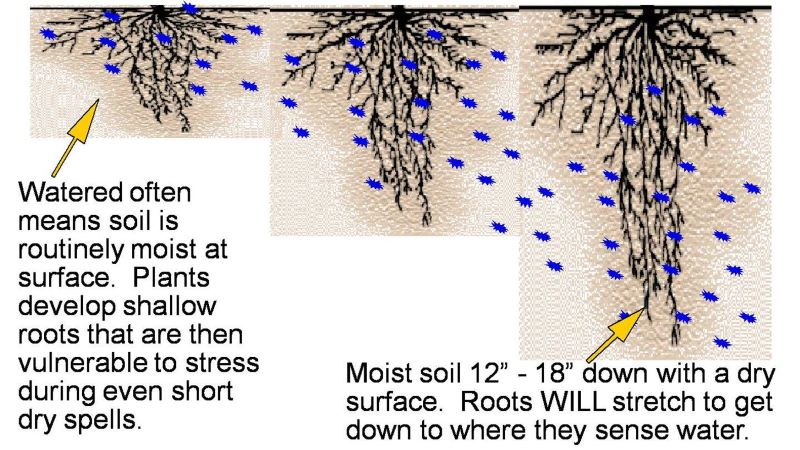 Quite simply, we promote a false
sense of security and make them lazy with our pampering. Under
these conditions, it would take just one rainless weekend away from
your garden, or just one failure of an irrigation system, for these
plants to show signs of drought stress since their roots had been
trained to stay near the surface where temperature fluctuations are
extreme.
Quite simply, we promote a false
sense of security and make them lazy with our pampering. Under
these conditions, it would take just one rainless weekend away from
your garden, or just one failure of an irrigation system, for these
plants to show signs of drought stress since their roots had been
trained to stay near the surface where temperature fluctuations are
extreme.It is far better to not water at all, and make your plants stretch down for their water. They will be much stronger having developed a larger and deeper root system, and fully able to glide through the long hot days of July and August unscathed. Their roots will be down a good 12 - 18" or more where it is usually still cool and moist.
When drought is severe, such as we experienced last year, [that was 2001] some plants may be stressed to the point of entering an early dormancy and drop all their leaves as they try to cope with the lack of water. However, as with all forms of life, the instinct for survival is strong and long term survival skills are built into their DNA. They may drop or fold up their leaves in an effort to conserve moisture, but that's a sign that they're strong and alive - not that they're dying. They're doing what they know they must do for long term survival - conserve energy so they can make a come-back when conditions improve. If they have been trained to have a strong, deep root system, they will come back with flying colours. If they have shallow root systems because of frequent shallow watering, some may not
for
more topics and in-depth articles, visit our
new sister site at -
www.YRgardening.ca
your
LOCAL guide
to all things
gardening in York Region
link to...
 Here's some general guidelines for
watering your perennial beds -
Here's some general guidelines for
watering your perennial beds - 1) Don't ever water until at least the top 3" of soil is fully dry.
2) 2) If you feel watering is needed but only have time for a quicky, don't water at all. Instead, spend those few minutes you have giving any new plants a good deep drink.
3) When you do water your garden, a slow steady trickle right at the soil level is best. Overhead sprinklers waste a tremendous amount of water through evaporation (up to 1/3) before it ever has a chance to get to the roots, and the constant moisture on the leaves promotes disease and rot problems. I used to devote an afternoon to moving around a little fountain type sprinkler at a very low pressure setting to really soak any area that needed it for about an hour. Visualize the root zone of your plants, not the soil surface. Your goal is to have moist soil at the bottom of the root system and beyond to encourage roots downward - that means about 12" - 18" down. If your watering efforts only went 3-4" deep, then that's where the plant's roots will stay and you've actually done more harm than good.
4) If you have conditions such as a slope or hard clay which tries your patience, try taking a plastic jug with the bottom cut out and burying it upside down beside your moisture lovers to deliver water directly to the root area instead of the soil surface. Most of your plants will still need to fend for themselves, but at least you can cater to those few that need your help.
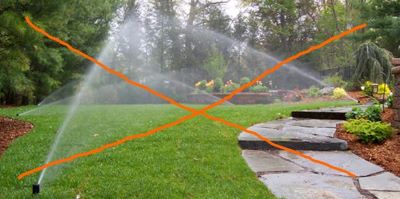 5)
Irrigation systems may be great for lawns but they can
mean outright death for a perennial garden.
They are often on timers set to run every couple of days for just 20
minutes or so. The shallow roots of lawn grass are grateful,
but after a few years your perennial gardens develop a mass of
roots at the surface that is completely vulnerable to the constant
stress of temperature and water fluctuations, and this
constant stress leaves them generally weak. The
problem multiplies upon itself once this happens since
the thick mass of fine roots that ends up blanketing the whole soil
surface actually starts to either shed water or hold water like a
sponge, preventing water from percolating down. A few years of
this and your perennials have, ironically, adapted to desert-like
conditions where there is never water held deep in the soil and
plants develop their roots in a wide reaching surface skirt to catch
and use every single drop of rain that falls before it
evaporates. If you have an irrigation system, aim
the heads at the lawn only and use soaker hoses (or nothing at
all) in your perennial beds.
5)
Irrigation systems may be great for lawns but they can
mean outright death for a perennial garden.
They are often on timers set to run every couple of days for just 20
minutes or so. The shallow roots of lawn grass are grateful,
but after a few years your perennial gardens develop a mass of
roots at the surface that is completely vulnerable to the constant
stress of temperature and water fluctuations, and this
constant stress leaves them generally weak. The
problem multiplies upon itself once this happens since
the thick mass of fine roots that ends up blanketing the whole soil
surface actually starts to either shed water or hold water like a
sponge, preventing water from percolating down. A few years of
this and your perennials have, ironically, adapted to desert-like
conditions where there is never water held deep in the soil and
plants develop their roots in a wide reaching surface skirt to catch
and use every single drop of rain that falls before it
evaporates. If you have an irrigation system, aim
the heads at the lawn only and use soaker hoses (or nothing at
all) in your perennial beds.  Perennials
in their first year need some watering help, but an
established perennial garden is actually better off left to
what comes naturally from the sky. If soil is prepared
well with plenty of organic matter in the form of compost, chopped
leaves, or peat moss, roots will have the food to grow strong, and
have an easy run to grow downwards where they're safe.
Mulching or using ground cover plants also helps conserve moisture,
but be careful not to pile mulch on or near the crown. If a
serious drought does come, un-pampered plants with their roots
trained deep, will be fully able to cope. They'll do the
smart thing by plunging even deeper for water. While we
gripe and complain about the heat, they'll be just fine. A few
leaves may get a bit tip burned, but that's about all the damage
I've ever experienced even after weeks with no rain.
Perennials
in their first year need some watering help, but an
established perennial garden is actually better off left to
what comes naturally from the sky. If soil is prepared
well with plenty of organic matter in the form of compost, chopped
leaves, or peat moss, roots will have the food to grow strong, and
have an easy run to grow downwards where they're safe.
Mulching or using ground cover plants also helps conserve moisture,
but be careful not to pile mulch on or near the crown. If a
serious drought does come, un-pampered plants with their roots
trained deep, will be fully able to cope. They'll do the
smart thing by plunging even deeper for water. While we
gripe and complain about the heat, they'll be just fine. A few
leaves may get a bit tip burned, but that's about all the damage
I've ever experienced even after weeks with no rain. In my last home, I established a garden bed in an area dominated by mature cedars that sucked the ground dry in a blink. I was determined though, and with persistence, I grew hosta, bleeding heart, etc. with moderate success. The first year I made sure to water very deeply once a week. In the second year, I watered deeply only when 2 weeks had gone by with no rain. In the third year, I watered only during the really dry times in August - and again, very deeply with a soak of at least a few hours. Astilbe and some of the hosta just couldn't thrive in this bed, but many other perennials did. Many survived, but they certainly looked pretty sad in their struggle.
When I moved and dug up some of these plants to take with me, I had to go down 18" - 20" before I gave up and simply cut the roots. They had reached down much more than they naturally would have in their quest for water. This was a huge teaching moment for me that gave me the confidence to start trusting that perennial plants know how to fend for themselves and survive. It was a real "Daahh" moment. I fully realized that plants are dynamic living things just like us, and that like all healthy living things, they will struggle with all their power to adapt and survive - to go to where the food and water is if it isn't near at hand.
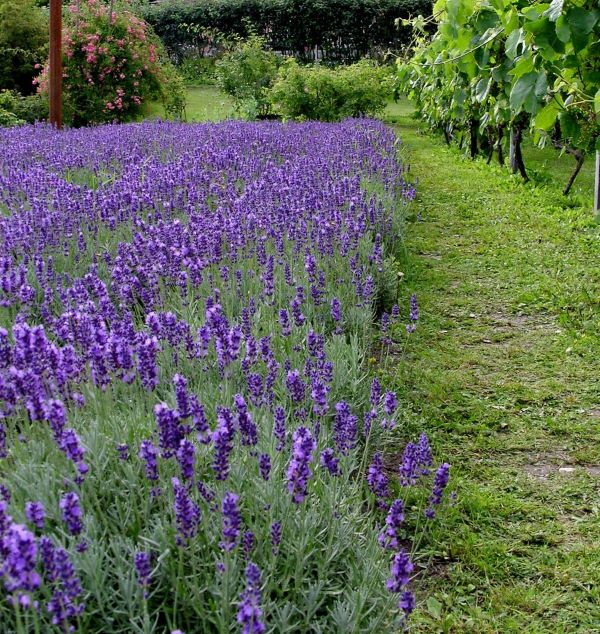 Just like us, they won't say "oh well" and just keel over and
die! They'll work hard, and have the DNA encoded drive
and know-how to do it.
Just like us, they won't say "oh well" and just keel over and
die! They'll work hard, and have the DNA encoded drive
and know-how to do it. Now, only real moisture lovers like my Ligularia, or the many new plants I put in each year, get any watering attention from me at all. Dryland lovers like Flax, Yucca, Artemesia, Lavender, Eryngium and others now grow tight and strong rather than weak and floppy as would happen in a wet garden, and come back reliably each year rather than succumb to crown rot. As I visit other gardens through my gardening services work, it's been my observation that MANY more plants die from crown rot through overwatering than die because of drought. Crown rot through overwatering is about the only way established plants ever truly die.
Perennials are tough as nails survivors with the ability to live longer than we do. They know how to struggle through and adapt to all kinds of hostile conditions. When at least their basic needs are met, they quickly adapt to their surroundings and begin the struggle for survival. They will adapt to dry hot conditions by sending roots deep to reach the moist sub-soil. They will adapt to crowding above ground by stretching their stems and leaves as tall and straight as they can, to reach for their fair share of sunlight. They will adapt to nutritionally lean soil conditions by growing tight and compact instead of lush and large. They will adapt to a bit too much shade for their liking by putting out larger leaves to catch just a few more of the sun's rays. Bottom line, plants aren't stupid! They know how to survive. ... sometimes in spite of gardeners rather than because of them!
My plants are better than ever for this lesson learned, but I have to confess that I feel a bit rejected now that I realize that they really don't need me at all once I've gotten them past their first few months. (Perhaps this
 is
why I'm always compelled to buy new plants!). I miss
that lazy hour at the end of the day when watering would give me
an excuse to linger in the garden a bit longer. To
accommodate this little pleasure and sooth my bruised ego, I keep
a small patch of moisture lovers in a naturally dry spot just so
that I can still feel needed. It works!
is
why I'm always compelled to buy new plants!). I miss
that lazy hour at the end of the day when watering would give me
an excuse to linger in the garden a bit longer. To
accommodate this little pleasure and sooth my bruised ego, I keep
a small patch of moisture lovers in a naturally dry spot just so
that I can still feel needed. It works! Cheers! Evelyn
© Evelyn Wolf, 2019 All rights reserved. Please contact for permission to use.

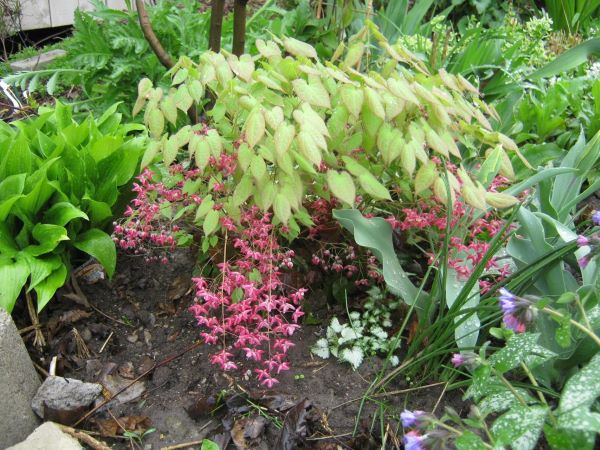 nails
go-to for even the dryest ground. A huge bonus is that it's
also a plant that will thrive in shade as well. (There
are only a half dozen or so different plants that won't fizzle
out in a garden under a mature Maple, and this is one of them!).
Extremely delicate texture to both the leaves and flowers, it adds
a soft touch to any mix of plants. Bloom's in late spring
around daffodil time. There are a f
nails
go-to for even the dryest ground. A huge bonus is that it's
also a plant that will thrive in shade as well. (There
are only a half dozen or so different plants that won't fizzle
out in a garden under a mature Maple, and this is one of them!).
Extremely delicate texture to both the leaves and flowers, it adds
a soft touch to any mix of plants. Bloom's in late spring
around daffodil time. There are a f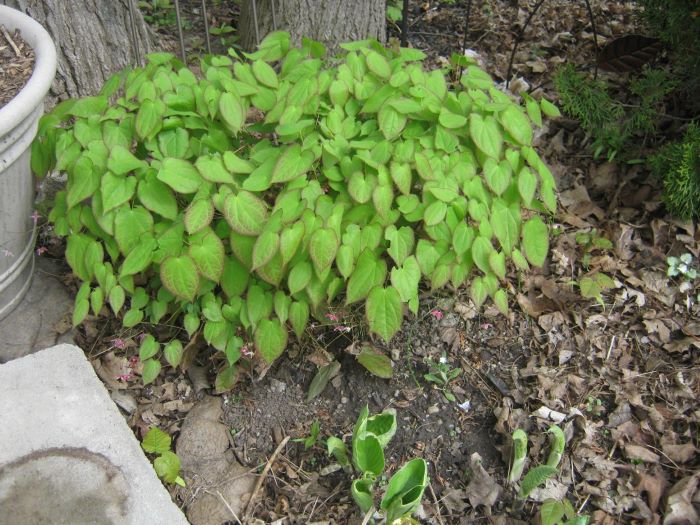 ew different cultivars
available, but this one I've found to be the happiest in our more
or less standard garden conditions.
ew different cultivars
available, but this one I've found to be the happiest in our more
or less standard garden conditions. 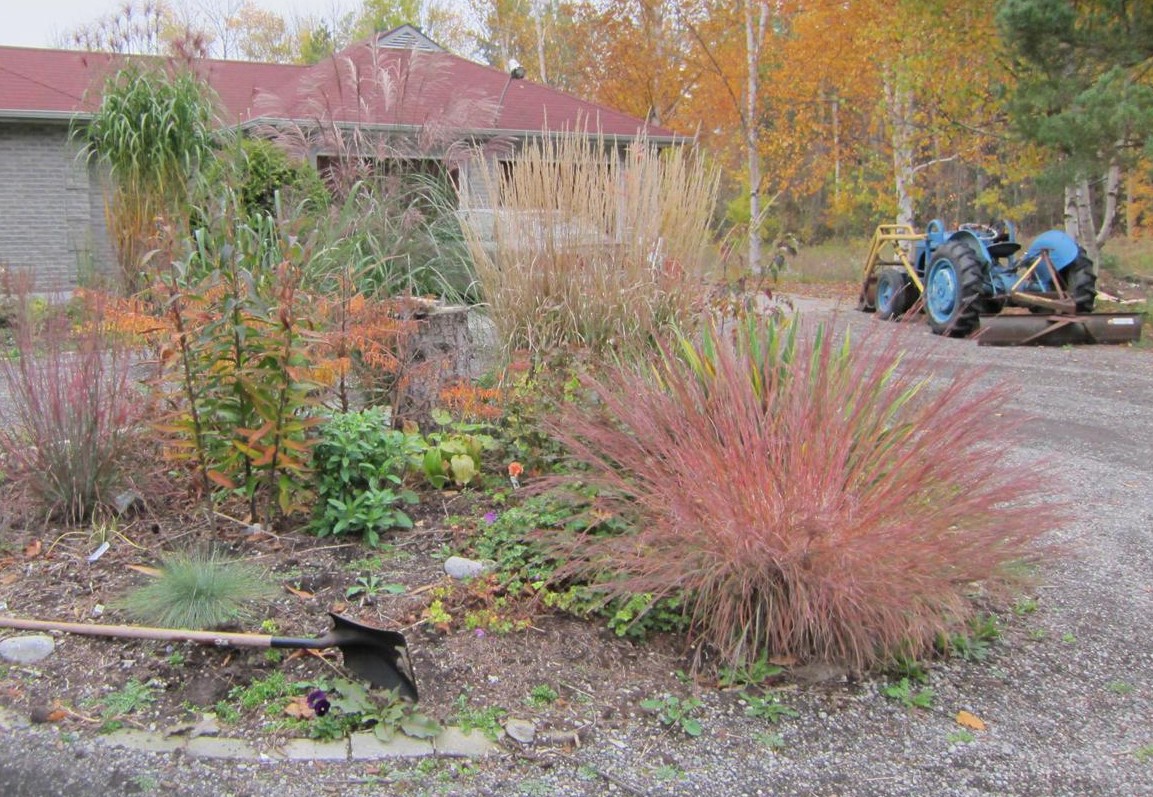 ornamental grasses are
drought tolerant, this one demands dry conditions to be
worth planting it at all! In medium moisture
conditions Little Blue Stem is a so-so straggly thing, but give it
some hot, gravelly, dry ground and it's at it's toughest best,
with colours unrivaled by any of the other ornamental grasses in
fall. (In this picture, it's mid October, and the colour
is only getting started!) It's a warm season grass
that doesn't even emerge from the ground until early June (good
place for spring tulips), but expands into a colourful
fireworks display by October and November, and right into
winter. Even at the end of winter the stems still hold up
strong and have a rich cinnamon colour. You can't do better
for a dry garden centerpiece.
ornamental grasses are
drought tolerant, this one demands dry conditions to be
worth planting it at all! In medium moisture
conditions Little Blue Stem is a so-so straggly thing, but give it
some hot, gravelly, dry ground and it's at it's toughest best,
with colours unrivaled by any of the other ornamental grasses in
fall. (In this picture, it's mid October, and the colour
is only getting started!) It's a warm season grass
that doesn't even emerge from the ground until early June (good
place for spring tulips), but expands into a colourful
fireworks display by October and November, and right into
winter. Even at the end of winter the stems still hold up
strong and have a rich cinnamon colour. You can't do better
for a dry garden centerpiece. 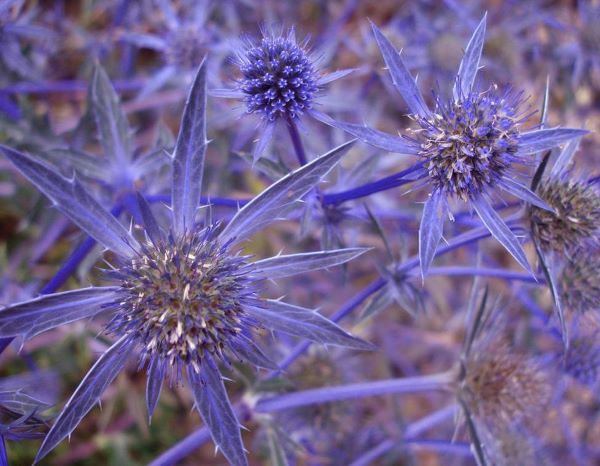 a colour the grabs the
eye no matter how large the garden. Truly a dry loving plant
though so if you're planting it among other standard perennials,
create a bit of a mound - 6" or so will do - and plant it on top
of the mound so any water immediately drains away from the crown.
(I lost my stunning 3 year old clump to crown rot in last years
relentless rain! Grrrr). Going out of your way to
search this particular hybrid is worth it - the flowers (actually
bracts) are huge and the colour intense. The standard one I
see around is half the size and not as blue.
a colour the grabs the
eye no matter how large the garden. Truly a dry loving plant
though so if you're planting it among other standard perennials,
create a bit of a mound - 6" or so will do - and plant it on top
of the mound so any water immediately drains away from the crown.
(I lost my stunning 3 year old clump to crown rot in last years
relentless rain! Grrrr). Going out of your way to
search this particular hybrid is worth it - the flowers (actually
bracts) are huge and the colour intense. The standard one I
see around is half the size and not as blue. 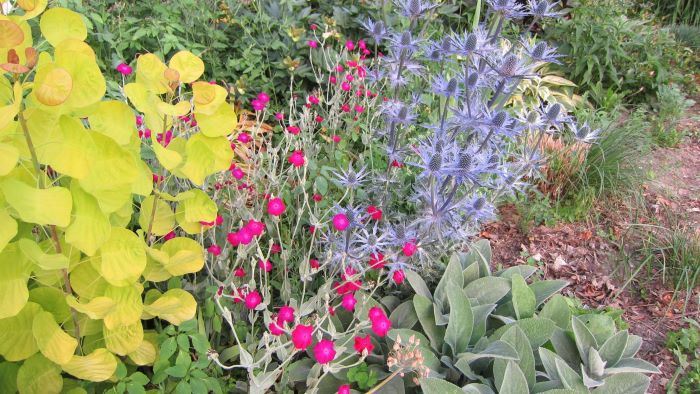 mix! 3-4" diameter
round leaves are brightest in early summer,, but the colour holds
for the whole season. Very drought tolerant with extremely
deep roots, you have to plant it where it's to stay - there's no
digging it up once it's in the ground for a year or
two. Let it grow tall and slim as a small tree or do a
severe coppice style pruning on it each spring to keep it to a
bushy small size to mix with flowering perennials. (The
photo on my home page here is another example of how this
yellow leaved form of smokebush can add lots of punch to a
deep coloured flower.). Here it's partnered
with a bright Lychnis coronaria and Eryngium 'Big
Blue'. Good in the driest of spots after it's given a bit of
watering TLC for the first few months.
mix! 3-4" diameter
round leaves are brightest in early summer,, but the colour holds
for the whole season. Very drought tolerant with extremely
deep roots, you have to plant it where it's to stay - there's no
digging it up once it's in the ground for a year or
two. Let it grow tall and slim as a small tree or do a
severe coppice style pruning on it each spring to keep it to a
bushy small size to mix with flowering perennials. (The
photo on my home page here is another example of how this
yellow leaved form of smokebush can add lots of punch to a
deep coloured flower.). Here it's partnered
with a bright Lychnis coronaria and Eryngium 'Big
Blue'. Good in the driest of spots after it's given a bit of
watering TLC for the first few months.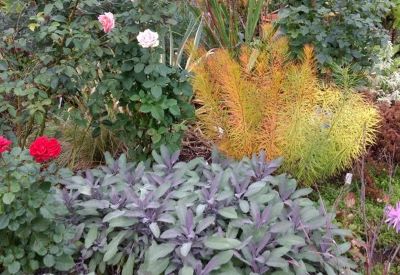 right under our noses! Common sage
comes in some leaf variations that make them great ornamental
plants. Here, the purple leaved variety pairs nicely with
the plain green plants around it, plus offers form and texture
contrast to Amsonia hubrechtii's feathery leaves (here
in it's fall golden colour phase). There is
also a variegated (two-tone) variation of sage
with white margins on the standard grey/green leaves. I've
also seen a tri-colour one that brings together the white edge
that's further edged with purple, on the grey/green background.
Extremely drought tolerant small shrubs that are
trouble free - other than when they have to endure too much water
when the leaves get mildewy and some stems rot at the base.
Plant Sage near the edge of a garden by some hot paving - these
Mediterranean natives love the heat! All they need is a bit
of pruning each year to take out old stems and then the remaining
stems cut back to around half. It will then grow in a neat
dome to contrast with any nearby upright plant.
right under our noses! Common sage
comes in some leaf variations that make them great ornamental
plants. Here, the purple leaved variety pairs nicely with
the plain green plants around it, plus offers form and texture
contrast to Amsonia hubrechtii's feathery leaves (here
in it's fall golden colour phase). There is
also a variegated (two-tone) variation of sage
with white margins on the standard grey/green leaves. I've
also seen a tri-colour one that brings together the white edge
that's further edged with purple, on the grey/green background.
Extremely drought tolerant small shrubs that are
trouble free - other than when they have to endure too much water
when the leaves get mildewy and some stems rot at the base.
Plant Sage near the edge of a garden by some hot paving - these
Mediterranean natives love the heat! All they need is a bit
of pruning each year to take out old stems and then the remaining
stems cut back to around half. It will then grow in a neat
dome to contrast with any nearby upright plant.